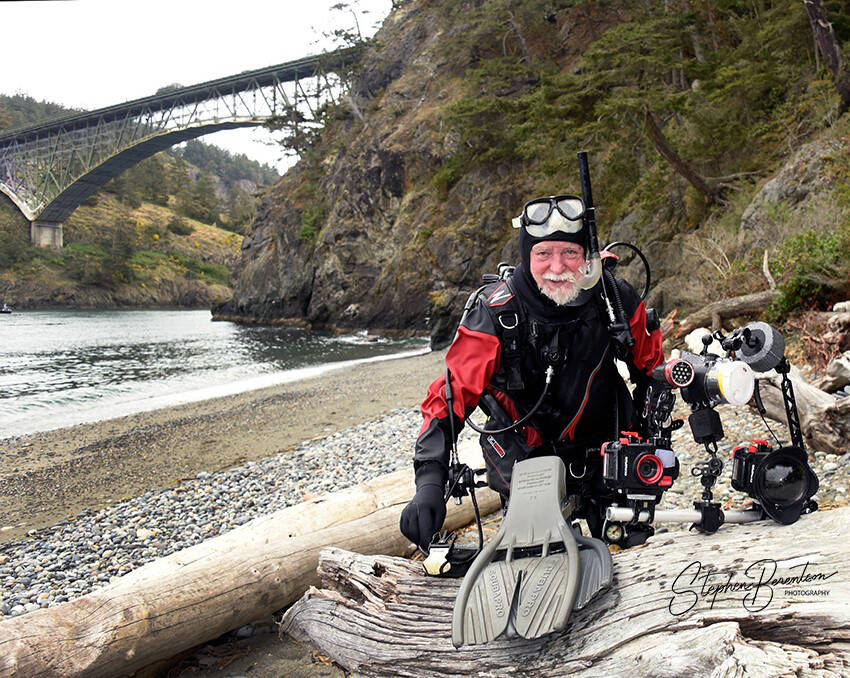Longtime Whidbey diver Jan Kocian has circled the island exploring the marine environment. It looks a lot different than it used to, he said.
“That diversity is gone,” he said. “It’s unfortunately in every location on the island. The diving is not even close to what it used to be. I know I sound like an old guy.”
According to the Pacific Biodiversity Institute, the Salish Sea was one of the most productive and diverse marine ecosystems in the world and has seen a 300-year decline caused by overfishing, by-catch, pollution, dredging and coastal development.
Fishing is just one factor, Kocian said. Fish numbers have depleted, but so have all kinds of species no one eats, like sponges.
“The dying of all the sea stars, that was another nail on the coffin,” he said. “They try to come back, but it’s an uphill battle for them unfortunately.”
Sea stars along the West Coast experienced a massive die-off in 2013 and 2014 due to a disease called sea star wasting syndrome, according to the Multi-Agency Rocky Intertidal Network.
Kocian started diving rivers and freshwater quarries in Czechoslovakia in 1964. During the Soviet invasion four years later, he sought asylum in the United States. His love for the ocean brought him to California. From there, he lived on the Marshall Islands and eventually found his way to Whidbey almost 30 years ago.
Pat Beach took ownership of the Whidbey Island Dive Center in the mid-90s as a retirement gig, he said. He’d come from an 11-season career as a tight end for the Baltimore Colts, Philadelphia Eagles and Pheonix Cardinals. His dive hobby came from vacationing in Hawai‘i.
The Whidbey Island Dive Center shut its doors in October 2018 as Beach was ready to “kick back,” he said, but Kocian keeps its Facebook page up to date with information to this day. Multiple times a week, he posts photos with location, date, time and species witnessed.
“The nice thing about diving for me is that every time you go underwater, you never know what you will see,” Kocian said. “Even after all those years, there are days where I find some new cleaner which I didn’t even notice before. I supply the pictures to people who are involved in science.”
Most biologists don’t have the luxury to dive three times a week like Kocian does, so often he gets email requests from researchers in the area.
In 2014, Kocian supplied photos regularly for Cornell University’s studies on sea star wasting syndrome, he said, and in 2015 he was invited to give a presentation on it for a Seattle symposium.
Out-of-towners also reach out to Kocian with diving questions based on his photos, he said, so he’s a bit of a tour guide as well.
Diving over and over the same locations enables him to see changes even on a small level. Three years in a row, Kocian saw a sea jelly no bigger than a quarter-inch. That wouldn’t be possible without diving in the same spot with persistence.
“Everybody wants to see a big octopus, but there’s a lot of beauty in very small stuff,” he said. “You can always find something which you never found before.”
Big interactions are fun too, he said, like predation and mating displays.
When sea stars mate, they curl their “toes” up and the sperm and the egg are visible. Kocian often sees male lingcod guarding the eggs in their nest.
Whidbey’s biggest dive challenges are weather related, he said. When the wind blows from the south, divers must pay attention to the tide and currents closely, as whole areas of the island become unsafe to dive.
That’s what makes Whidbey divers unique, Beach said.
“Most of the guys that dive in cold water are 10 times the (normal) diver because we deal with limited visibility and cold water and a lot more gear,” he said. “It’s cold, and it’s not as luxurious. The guys that are diving on the island or in the Pacific Northwest or Canada, they’re pretty hardcore, dedicated divers.”
One of Kocian’s favorite dives was the cenotes in Yucatan, Mexico, he said, or the Bikini Atoll in the Marshall Islands, where he dove through the USS Saratoga, an aircraft carrier which sank during a 1946 nuclear test.
There’s a lot of life in the marine ecosystems around Whidbey, he said. Goliath lingcod, rocks forested with anemone. Someone who started today would have no idea the change over the decades. It still holds immense beauty, but he can’t help but remember the old days.
“God, I wish the diversity was there,” he said. “Deception Pass is another example that used to have so much color, and now a lot of the big anemones, the finger sponges. They’re still there but not in the numbers (they used to be).”


